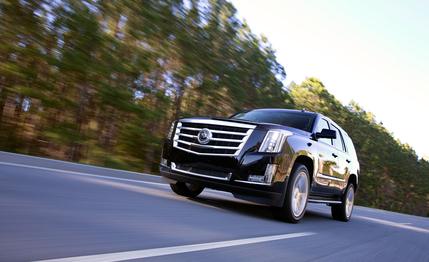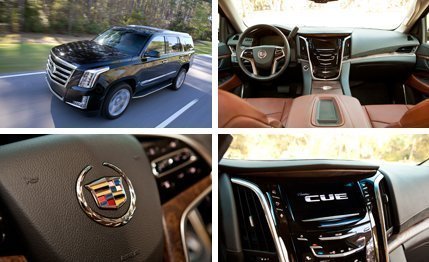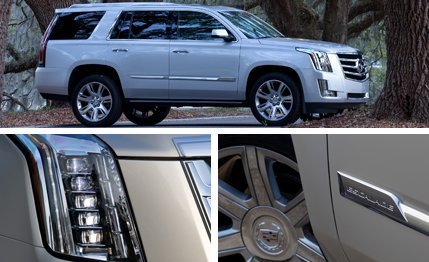 First Drive Review
First Drive Review
When the Cadillac product team describes it as “the Escalade of Escalades,” you can surmise that this 2015 model-year redesign is not a rethinking of the brand’s three-row, body-on-frame SUV. The Escalade remains the Cadillac of GM’s new full-size-truck platform, GMT K2, related to Chevrolet’s Tahoe and Suburban and the GMC Yukon brothers big and bigger. As before, there are actually twin Escalades, the 116.0-inch-wheelbase model and the Suburban-sized Escalade ESV, which gets a 14.0-inch stretch. Cadillac isn’t saying much about the third member of the family that disappeared after the 2013 model year, the flamboyant Escalade EXT pickup. Perhaps it ran off to Hollywood.
The remaining members of the family seem headed in the opposite direction, with sharper and more conservative styling to better integrate in upscale communities. The Escalade now seems apiece with the full-size XTS and the brand’s other sedans, mature in their decade-long evolution of Cadillac’s Art & Science design. From a distance, the high beltline, the rectilinear greenhouse, and the forward-canted C-pillar manifest the look of a vintage Fleetwood station wagon. Of course, such a thing never actually existed, at least not officially, and anyway, the illusion breaks once you get close enough to recognize the Escalade’s larger-than-life size.

Small has never been a Cadillac virtue, so even in our downsizing world, the Escalade keeps growing. The new version is 1.4 inches longer, 1.5 inches wider, and a few pounds heavier than the outgoing model. A new, direct-injected 6.2-liter V-8 produces 17 more horses and 43 extra lb-ft of torque. Yet this 420-hp engine, shared with Denali-spec GMC Yukons, delivers better fuel economy. EPA estimates go up by 1 mpg in the city and 2-to-3 mpg on the highway, but even the highest-rated model, a short-wheelbase rear-driver, manages only 17 combined.
Under the Big Top
The Cadillacs and the GMCs share the rest of their mechanical packages as well, including a live rear axle, magnetorheological dampers, and a new electric power-steering system. The Escalades get an optional sport mode to stiffen up the shocks, but the ride is firm and controlled enough without engaging it. Weighty steering and a firm brake pedal accurately translate driver inputs, while offering excellent communication for such a big vehicle. If you steer this Titanic into an iceberg, you’ll have only yourself to blame.
Inside, the Escalade’s leather-wrapped interior looks like something fit for a super-sized CTS. There’s plenty of square footage for seven passengers (or eight if the second-row buckets are replaced with a bench) to disassociate with their smartphones. The driver even gets screen time, thanks to a 12.3-inch display that replaces the conventional gauges in the instrument panel. As with its platform-mates, the Cadillac version offers a roomier front seat than before, the short-wheelbase model gets larger rear door openings to make climbing in and out easier, and a raised cargo floor allows the power third row to fold flat.

Cadillac’s eight-inch touch-screen infotainment system nestles in the center of the dash, and if CUE looks more diminutive in the huge SUV than in, say, an ATS, it is every bit as frustrating to use. This is one of the few features unique to the Cadillac version of the K2, and it might serve as sufficient motivation for some customers to seek out whichever motor mall contains their local GMC store. Remember: Denali ain’t just a mountain in Alaska, and the SUV of that name uses an infotainment system with more conventional knobs and buttons.
Escalade pricing starts just past the Denali’s, at $72,690 for the short-wheelbase model and $75,690 for the ESV, but GM expects most Escalades to be optioned up. The $4000 Luxury package includes 22-inch wheels (20s are standard) and safety equipment such as collision alert and lane-departure warning. The $8500 Premium package contains more advanced safety features like automatic braking and adaptive cruise control, as well as a nine-inch rear entertainment system. Four-wheel drive adds $2600 to the price, which can nudge the bottom line over $90,000 for a loaded ESV.
Yes, that makes the Escalade the most expensive Cadillac you can buy, as well it should be. Despite a new lineup of vastly improved cars such as the CTS, a 2014 10Best Cars winner, Cadillac has a loyal following of Escalade buyers who believe the brand is better at making trucks than anything else and has a styling heritage that might best be described as “show me the money.”